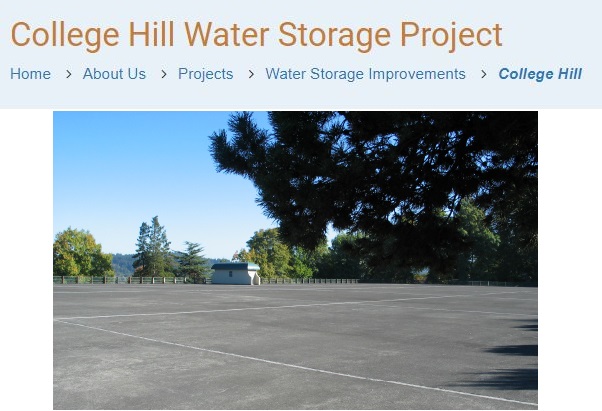EWEB eyes 2024 start for new College Hill tanks
4 min read
from Aaron Orlowski, Eugene Water & Electric Board
EWEB will dismantle the leaky and antiquated 80-year-old College Hill Reservoir and replace it in the next few years with new, modern drinking water storage tanks built to withstand major earthquakes.
Construction could begin as early as 2024.
The reservoir – which serves all homes and businesses, and provides emergency water for critical community needs, including fire suppression – is nearing the end of its useful life and fails to meet current seismic standards. It is unlikely to survive a major earthquake, resulting in Eugene losing critical supplies of safe drinking water in the event of a disaster.
In addition, the Oregon Health Authority (OHA) is requiring EWEB to rehabilitate or decommission the reservoir by the end of this year because of leaking roof joints, which create the potential to degrade the water quality.
“Our top priority is ensuring supplies of healthy drinking water everyday – including when disaster strikes,” said EWEB Chief Operating Officer Karen Kelley. “We’re making decisions about how and when to dismantle and rebuild water storage at College Hill based on the needs of our community for safe, reliable water, efficient operation of the water system as a whole, and costs to customers.”
EWEB informed neighbors in 2020 of plans to take College Hill out of service and has spent nearly three years evaluating a demolition and construction schedule.
College Hill’s crucial role in EWEB’s water system
The reservoir was built during the Great Depression as part of Franklin D. Roosevelt’s Works Progress Administration program. In the decades since, the 15-million-gallon reservoir has been part of the backbone of Eugene’s water system.
College Hill is part of a network of tanks, referred to as “base level” storage. The existing base level system includes College Hill, a 20-million-gallon tank on Hawkins Lane, and a 20-million-gallon tank in Santa Clara.
To maintain sufficient water pressure throughout the system, EWEB must develop replacement base level storage before draining the College Hill Reservoir. To do so, EWEB is building new storage tanks near E. 40th and Patterson St. Construction started in 2021 and is on-schedule for completion later this year.
“Pending completion of the replacement storage at E. 40th, EWEB can move forward with the next steps in our Water System Master Plan, which aims to replace all of our base level reservoirs with new, seismically resilient storage tanks,” said Karen Kelley. “Based on recent assessments of EWEB’s base level reservoirs, we determined that College Hill will be the next reservoir to be replaced.”
During those recent assessments, EWEB discovered that the cover for the Santa Clara reservoir is nearing the end of its useful life, sooner than previously anticipated.
“We will need replacement storage in order to take Santa Clara out of service and it makes sense to construct at College Hill next because EWEB has existing OHA requirements to decommission that facility by end of 2023,” said Kelley.
The Hawkins tank will eventually need to be replaced as well for seismic reasons, but that facility is newer; it was constructed in 1963 and has passed OHA inspections.
New tanks at College Hill
EWEB plans to replace the existing 15-million-gallon College Hill Reservoir with two smaller tanks that will store 7.5 million gallons each, comparable to the tanks currently under construction at E. 40th. Smaller tanks are part of an EWEB strategy to diversify Eugene’s water storage system, enhancing resiliency, water quality, and operations.
Removing the existing College Hill Reservoir will create changes for the neighborhood. The 2.5-acre paved top of the reservoir has served as a public space for decades. At this time, EWEB anticipates that the public will continue to have access to the top of the existing reservoir at least through 2023, but the new tanks, once constructed, will be fenced to protect drinking water quality.
“Contemporary public health standards require that drinking water facilities need to be secure. That’s just common sense,” said Kelley. “We plan to maintain open public space at College Hill outside of the fenced tanks, and we will be inviting public input on landscaping, recreational facilities and other amenities.”
Demolition and construction at College Hill could begin as early as 2024. EWEB will spend the next several months developing preliminary engineering plans and project schedules.
According to Oregon’s State Historic Preservation Office (SHPO), the facilities at the College Hill Reservoir are identified as historically significant. EWEB is working with the SHPO and plans to invite public input on ways to honor the historic nature of the site once the reservoir is removed.
About the Eugene Water & Electric Board
The Eugene Water & Electric Board is Oregon’s largest customer-owned utility. Founded in 1911, EWEB provides water and electricity to approximately 96,000 customers in the Eugene-Springfield area. EWEB’s service area covers 236 square miles with a population of more than 200,000 people, including major institutions such as the University of Oregon. A five-member elected Board of Commissioners governs the utility, which does not operate to earn a profit or to serve the investment needs of stockholders.
Employing approximately 500 people, EWEB serves the people of Eugene by embodying core values of safety, reliability, responsibility and community. EWEB owns four energy generation facilities, including hydroelectric projects on the McKenzie and Clackamas Rivers, and leads watershed protection measures with local landowners and environmental organizations. With one of the greenest energy supplies in the nation, approximately 90% of EWEB’s power comes from carbon-free sources, and EWEB is committed to achieving a 95% carbon-free energy portfolio by 2030.





